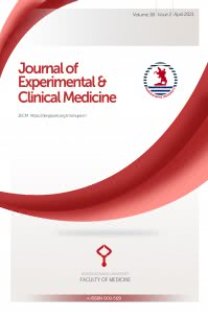ARDS'l, bir olguda acil serviste erken mekanik vantilasyon tedavisinin başlanması ile sağlanan başarı
Solunum güçlüğü sendromu, erişkin, Solunum bozuklukları, Ergen, Acil tedavi, Ventilatörler, mekanik, Ventilasyon
Early ventilatory management at emergency department of a patients with severe acute respiratory distress syndrome (ARDS)
Respiratory Distress Syndrome, Adult, Respiration Disorders, Adolescent, Emergency Treatment, Ventilators, Mechanical, Ventilation,
___
1. Fein AM, Calalang-Colucci MG. Acute lung injury and acute respiratory distress syndrome in sepsis and septic schock. Critical Care Clinics 2000; 12: 289-317. 2. Bigetello LM. Ventilatory management of. severe acute respiratory failure for Y2K.Anesthesiology 1999: 91: 1567-1570. 3. Sachdeva RC. Guntupalli KK. Common issues in pediatric and adult clinical care. Critical Care Clinics 1997: 13: 503-521. 4. Valta P. Uusaro A, Nunes S, et al. Acute respiratory distress syndrome:Frequency. clinical course, and costs of care. Critical Care Medicine 1999; 27: 2367-2374. 5. Rocco TR, Reiner t SE, Cioffl W. A 9 year, single retrospective review of death rate and prognostic factors in adult respiratory diatress.Annals of Surgery 2001; 233: 414-22. 6. Krishnan JA. Brower RG. High-frequency ventilation for acute lung injury and ARDS. Chest 2000; 28: 3913-9.7. Amato MBP, Barbas CSV, Medeiroe DM, et al. Effect of a protective-ventilation strategy on mortality in the acute respiratory distress syndrome. N Engl j Med 1998; 338: 347-354 (A). 8. Headley AS, Tolley E, Meduri GU. Infections and the inflamotory response in acute respiratory distress syndrome. Chest 1997; 111: 1306-1321. 9. Jansen R, Zienfub T. Mekanik ventilasyon. Çev. Erinçler Tuna. Bans yayınları, İzmir, 1999, s. 383-395. 10. Gürsel G. Akut Solunum Sıkıntısı Sendromu. Göğüs hastalıkları Acilleri. Ankara, Bilimsel Tıp Yayınevi, .2000:197-210. 11. O'Connor MF, Hall JB. Respiration in anesthesia pathophysiology and clinical update. Anesthesiology Clinics of North America 1998; 16: 155-180. 12. Sessler CN. Mechanical ventilation of patients with acute lung injury. Critical Care Climes 1998; 14: 707-729. 13. Orebaugh SL. Initation of mechanical ventilation in the Emergency Department. American Journal of EM 1996; 14: 59-69.
- ISSN: 1300-2996
- Yayın Aralığı: Yılda 4 Sayı
- Başlangıç: 2018
Zahide DOĞANAY, Fikret BİLDİK, Dursun AYGÜN, Hakan GÜVEN, Levent ALTINTOP, Murat YERLİYURT
Çocukluk çağı kanser hastalarının epidemiyolojik incelenmesi
Nilgün ÖZBEK, Şaban ÇAKIR, Baki TARAKÇI, Melek COŞKUN
Gaziantep il merkezindeki gebe kadınlarda A vitamin ve B-karoten düzeyleri
Şahin KILINÇER, İclal MERAM, Ali İhsan BOZKURT
The acanthosis nigricans associated with gastric adenocarcinoma and neurofibromatosis
Tayyar CANTÜRK, Levent YILDIZ, Asiye YILDIZ, Oğuz AYDIN, Ahmet Yaşar TURANLI
Motor eşgüdümde dopaminerjik sistemin rolü
Mehmet KURT, Süleyman ÇELİK, Yüksel KESİM
SEZGİN GÜNEŞ, Hasan BAĞCI, NURTEN KARA
Multipl sklerozda human lökosit antijen sıklığının incelenmesi
Hüseyin ATEŞ, Gülten TUNALI, Belma DURUPINAR
Sayit ALTIKAT, Mehmet Emin BÜYÜKOKUROĞLU, Mehemt ÇİFTÇİ, Nuri BAKAN, ÖMER İRFAN KÜFREVİOĞLU
